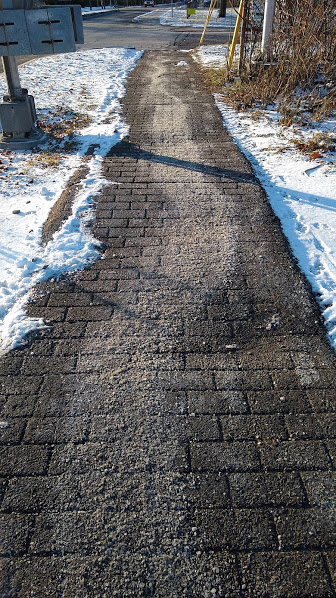Salt is the ubiquitous solution to icy roads and sidewalks, but it isn’t the only way you can keep from slipping during the winter. Excessive use of salt damages plants’ ability to absorb nutrients, and can affect aquatic life if it’s washed into a water body.
There are several ways you can reduce your salt runoff impact at home. The first, and most important thing you can do is to shovel as soon as possible after a weather event occurs. By removing the snow and slush right away you prevent new ice from adhering to the pavement.
Sand is another popular alternative to salt, but it can only provide traction and does not actually melt the ice. It can clog storm drains and harm water bodies through sedimentation and can be more harmful to aquatic life than salt.
Your fridge likely has some items that will help you reduce the slipperiness of the paved areas around your house. If you have a jar of pickles, pour the brine into a spray bottle and put it to work on your walkways. The green-hued juice acts similar to saltwater and can melt ice at temperatures as low as -6°F. And if you pre-wet your driveway with it before a winter storm, it will help prevent snow and ice from bonding with pavement making it easier to chip away at any ice accumulations. If you’re a lover of fresh mozzarella or other soft cheeses sold in containers of salty water, you can use the cheese brine in a similar way. According to transportation officials in Wisconsin where the cheese brine is abundant enough for highway use, it has the added advantage of working in temperatures down to -21°F.
If you do need to use salt, a little can go a long way. A brine solution of 23% salt and 77% water can be sprinkled on the sidewalk before a storm, and acts to prevent ice from adhering to the pavement. Wetting salt also makes it more effective at melting ice that’s already there. This should only be used in temperatures above 15°F, as lower temperatures run the risk of freezing the brine itself. Leave some sections of the sidewalk brine-free for extra safety, and shovel right away to make the most of the brine solution.
No matter which approach you decide to take, test new methods out on a smaller, less-traveled section of pavement. Studies in the Great Lakes region indicate that most of the non-point source pollution of fresh water from chlorides (salt) originate on private land and parking lots. By simply being mindful of your salt usage this winter you can make a positive difference in the Lake Champlain watershed.
